24 Hours Hotline: +86 137-3541-1378
Email:[email protected]
24 Hours Hotline: +86 137-3541-1378
Email:[email protected]
Qianling Museum Xi'an (Chinese: ???????)
Brief Introduction
The Qianling Museum is a mausoleums museum in China. It was founded in 1978, the museum is situated around the site of Qian Mausoleum. The Qian Mausoleum is where the third Tang-dynasty emperor and his empress were buried together. The third emperor was Li Zhi and his empress was Empress Wu Zetian. This is the most representative among the eighteen Tang-dynasty tombs and the best preserved. It is located on top of Liangshan. The scope of the tomb is very large with the precincts of the tomb and gardens totalling an area of 2,400,000 square meters. According to historical documents, a number of accompanying tombs surrounded the Qianling imperial-tomb precinct. These were mostly robbed in antiquity but certain superlative works of art remain that can be seen at this museum. It is well worth a visit.
History
Tang Emperor Li Zhi was the ninth son of Emperor Tai Zong and became the emperor in 649 when his father died. Emperor Taizong was a strong ruler, but Li Zhi was a weak ruler. His uncle Zhangsun Wuji helped him a lot, so he was made crown prince and ascended the throne upon Tai Zong's death. Though 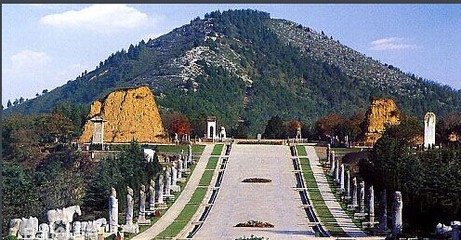 he was muddle-headed and weak-minded and accomplished little, the flourishing and stable state of early Tang was maintained during the first years of his reign, thanks to such veteran officials as Zhangsun Wuji and Chu Suiliang who actually usurped state power. However, once Wu Zetain moved into the palace, things began to change in the Tang regime power structure. Wu Zetian was from Wenshui, Shanxi Province. Her father was a successful wood merchant. She was one of the concubines of Taizong and then she cut down her hair and became a buddhist nun in 649. In 654, she was taken out of the monastery and brought into the palace by Emperor Gao Zong and as his chief concubine. The next year the Emperor deposed Empress Wang and named Wu Zetian his empress, allowing her to participate in state affairs. He dismissed and ostracized Chu Shuiliang and in 659 forced Zhangsun Wuji to commit suicide. From then on, Li Zhi remained in poor health, "faint, heavy-headed and sightless" as the chronicles described him, and Wu Zetain attended to most court affairs. Qianling Mausoleum was completed in 684. After Wuzetian passed away, she was interred in a joint burial with Emperor.The five attendant tombs mentioned above were opened and excavated in the 1960s and early 1970s. In March 1995, there was an organized petition to the Chinese government about efforts to finally excavate Emperor Gaozong and Wu Zetian's tomb.
he was muddle-headed and weak-minded and accomplished little, the flourishing and stable state of early Tang was maintained during the first years of his reign, thanks to such veteran officials as Zhangsun Wuji and Chu Suiliang who actually usurped state power. However, once Wu Zetain moved into the palace, things began to change in the Tang regime power structure. Wu Zetian was from Wenshui, Shanxi Province. Her father was a successful wood merchant. She was one of the concubines of Taizong and then she cut down her hair and became a buddhist nun in 649. In 654, she was taken out of the monastery and brought into the palace by Emperor Gao Zong and as his chief concubine. The next year the Emperor deposed Empress Wang and named Wu Zetian his empress, allowing her to participate in state affairs. He dismissed and ostracized Chu Shuiliang and in 659 forced Zhangsun Wuji to commit suicide. From then on, Li Zhi remained in poor health, "faint, heavy-headed and sightless" as the chronicles described him, and Wu Zetain attended to most court affairs. Qianling Mausoleum was completed in 684. After Wuzetian passed away, she was interred in a joint burial with Emperor.The five attendant tombs mentioned above were opened and excavated in the 1960s and early 1970s. In March 1995, there was an organized petition to the Chinese government about efforts to finally excavate Emperor Gaozong and Wu Zetian's tomb.
What to see in Qianling Museum
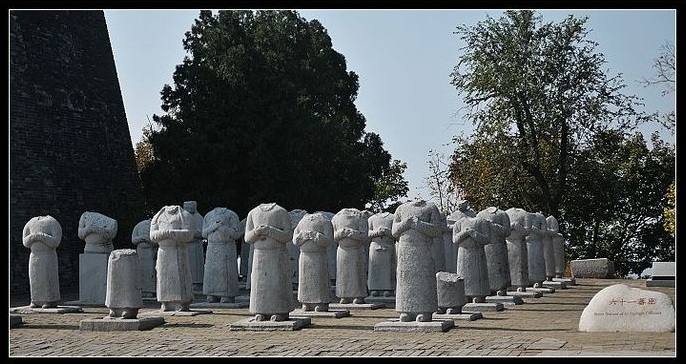
1. Stone Human Statues
On the right side of the path there are 61 stone human statues erected here in order to show us a powerful and prosperous Tang Dynasty and have a good relationship with others. Wu Zetian asked the chief-rains and foreign guests to caome here to commemorate the minority chieftains and foreign special envoys who attended the funeral. Wearing tight-sleeved clothes, broad belts and leather shoes, these figures cup their hands in front in an attitude of prayer. But you will notice that most of the statues with defaced head, just only two statues are completed with the western row. And you can find the nationalities and the name of them in the back.
2. Paintings
Since 1949, lots of tombs were unearthed in Qianling mausoleum, such as the Tomb of Yong Tai, who was the Princess. They are in the same surface appearence and structure, was surrounded by a wall, ornamental pillars on the south side, stone figures and stone sheep in precise order. The tombs themselves were composed of a passage way, an archway, a shaft, a corridor and ante-and rear-chambers. On two sides of the shaft were a series of niches containing a variety of three-color figurines, pottery and porcelain articles.
Frescoes adorned the walls and tops of the passage, the archway, the corridor and chambers. We can see some "Painting of Maids," which reflecting the parasitic imperial life; The archiectural designs part reflecting Tang Dynasty's architecture; What's more we can see the cultural exchanges and frendily relationships between China and the wolrd from these paintings. The themes on here are colorful, well composed and skillfully executed,. There is no doubt that Tang paintings stands in a high level and made a great influence in Chinese painting.
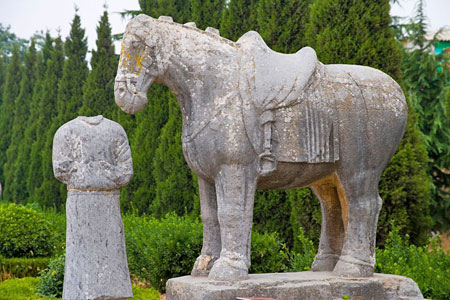
3.Uncharactered Tablet & Seven-section Stele
We can see two stone tablet on this area.On the east side,it's a tablet without character, it named Uncharactered Table,was erected blank as a term of Wu Zetian's will. This blank tablet was 6.3 meters in high. And also some people changed it into a charactered one, according to records they were 13 inscriptions in total.But the most famous one is Nuzhen script with a Chinese translation beside it was well preserved,but now we can't see this script,it was disspeared.This rare script was a precious aid for the study of Nüzhen scripts and the Chinese history and culture.The one on the west was Telling the Emperor's Deeds,and it also called Seven-Tiered Tablet because it was composed of seven tiers.It was written by Wu Zetian and carved in the handwriting of Emperor Zhong Zong, there are more than 8,000 characters with the golden powder. on this inscription in order to praises the achievements of Emperor Gao Zong.
4. Winged horse & Stone lion
The winged horses, wings decorated with slender, delicate lines, are in a flying gallop. Because supreme rulers considered themselves so upright their reign would be prosperous, they also wanted pairs of winged horses and rosefinches, representatives of propitious birds and beasts, to guard a prosperous underground life. The rosefinches, in high relief, were beautifully shaped and sturdily carved. It is said that because rosefinches were a gift from Afghanistan for the funeral and could serve as guards, a pair of them were erected in front of the tomb. We also can a pair of stone lions in front of the wall, They are symbols of dignified, autocratic Tang rulers.
Information
Location: Liangshan Mountain,North of Qian County.
Opening Hours: 08:00-18:00
Admisssion: 122RMB( peak seson); 82RMB( low season).
How to Get There
(1) Take bus from Xian west bus station to Qian County, and then take taxi to the north entrence of Qianling;
(2) Take taxi from Xianyang Airport to Xianyang north bus station and then take bus to Qian County, around an hour.
Prev: Small Wild Goose Pagoda
Next: Mizhi County
1. How to get to Qianling Mausoleum from Xian?
You can take train or long distance bus from Xian to visit Qianling Mausolum. Take a train from Xi'an Railway Station to Qianxian, and then take local Bus 1 to Qianling. Take a long distance bus from Xi'an West Bus Station to Qian County. After arrival, local bus 2 will take you to Qianling. We highly recommend you book a private transfer with local tour company, have your personal driver to take you around which is more flexible.
2. How much do i pay to visit the Qianling scenic area?
There price for Qianling Mausoleum is different in peak season & off season, the details as below:
1) Peak season (March-November): Qianling Mausoleum 45 Yuan, Yongtai Mausoleum Scenic Spot (Museum of Qianling Mausoleum) & Yide Mausoleum 25 Yuan, Zhanghuai Mausoleum 15 Yuan. Price of a coupon ticket for the above attraction: 70 Yuan.
2) Off season (December-February): Qianling Mausoleum 25 Yuan, Yongtai Mausoleum Scenic Spot (Museum of Qianling Mausoleum) & Yide Mausoleum 15 Yuan, Zhanghuai Mausoleum 5 Yuan. Price of a coupon ticket for the above attraction: 45 Yuan.
3. What are the famous things to visit in Qianling scenic area?
Qianling Mausoleum is the joint tomb of the Tang dynasty Emperor Gaozong and his wife, Empress Wu Zetian (the only one Empress in Chinese history). There are three wonders famous for the exquisite craftsmanship and historical value of Qianling Mausoleum: Stone Carving, Mural Painting and Tri-colored Glazed Pottery (called Tang Sancai in Chinese). The most attractive stone carving in the mausoleum is Wu Zetian’s stele without words.
4. My family will travel to Xian during the winter, will be a good time to visit Qianling Mausoleum?
Actually, Qianling Mausoleum can be visited all year around. It's not particularly affected by the weather, but the best time to visit are spring and autumn when the weather is comfortable. Summer is hot and humid in Xian and with many domestic tourists. If you travel to Xian during the winter, much less crowded in Xian city, it might be cold and snow. You should wear the Thick jacket, scarf, gloves and warm hat.
5. How far is Qianling Mausoleum from Xian?
Qianling Mausoleum Scenic Area is located about 87km northwest to Xian City, the scenic area is located in the Lingqian Village, Qian County, Xianyang City. If you travel from Xian by taxi or private transfer, it takes about 1.5 hours by driving from Xian downtwon.
Yes, we can arrange the Xian customized tour includes the Qianling & Famen temple from Xian airport. Feel free to send the details about your flight via our email. If you comfired all the tour details, our guide & driver will meet you at the airport with a welcome sign, they will take you to explore the Qianling Mausoleum & Famen temple from airport directly. Drop off at your designated place after the tour.
Duration:6-8 hours
Attractions(Cities):Terracotta Warriors and Horses Museum, Bell Tower, Muslim Quarter
Tour Style:If you're short on time but eager to experience Xi'an, our Xi'an private tour is the perfect solution. This all-inclusive one-day tour includes visits to the world-famous Terracotta Warriors, a UNESCO World Heritage Site, where you’ll marvel at thousands of life-sized statues. You’ll also explore the Bell Tower, a historic landmark offering panoramic views of the city, and stroll through the lively Muslim Quarter, sampling local delicacies and experiencing vibrant cultural blends. With hotel pickup, a professional guide, comfortable transport, and all entrance fees included, this Xi'an private tour offers a seamless and enriching experience, allowing you to uncover the best of Xi'an’s rich history and culture.
Duration:6-8 hours
Attractions(Cities):Xi'an Ancient City Wall, Big Wild Goose Pagoda, Xian Great Mosque, Muslim Quarter
Tour Style:This Xian city tour offers an immersive journey into the rich history and culture of this ancient city. Begin your day at the Shaanxi History Museum, where you'll explore China's long-standing civilization through its precious artifacts. Next, visit the Big Wild Goose Pagoda to experience the deep roots of Buddhist culture. At the Xi'an Great Mosque, marvel at the unique Islamic architectural artistry. Finally, stroll through the vibrant Muslim Quarter, where you'll savor the diverse flavors of Xi'an's food culture. This tour provides not only cultural enrichment but also exceptional service to ensure a memorable and enjoyable experience.
Duration:4-5 Hours
Attractions(Cities):Terracotta Warriors, Muslim Quarter
Tour Style:Experience the awe-inspiring Terracotta Army with our exclusive Xi'an Terracotta tour. Skip the crowds and enjoy a personalized exploration of this world-famous site, one of the "Eight Wonders of the World," with a knowledgeable local guide. With flexible pacing, you’ll have ample time to marvel at over 8,000 life-sized figures guarding the tomb of China’s first emperor, Qin Shi Huang. This tailored tour includes convenient city transportation, entrance fees, and expert guidance, ensuring a seamless and immersive experience. Dive deep into the history, culture, and fascinating stories of the Terracotta Warriors, uncovering the legacy of this remarkable archaeological treasure in Xi'an.
Duration:10-12 hours
Attractions(Cities):Terra-cotta Warriors, Local Xi 'an lunch
Tour Style:Embark on a seamless day trip to Terracotta Warriors from Beijing with a comfortable high-speed train ride to Xi'an. Upon arrival, your private, knowledgeable guide will greet you at the station and take you directly to the world-famous Terracotta Warriors, a UNESCO World Heritage Site. There, you'll marvel at the thousands of life-sized sculptures that once guarded the tomb of China's first emperor, Qin Shi Huang each figure uniquely detailed and steeped in ancient history. After your in-depth visit, enjoy a delicious local lunch featuring Xi'an specialties before returning to the train station for your journey back to Beijing. This well-organized private tour is ideal for travelers who want to experience one of China's most iconic sights in a single, hassle-free day.
Duration:8 hours
Attractions(Cities):Mt Huashan
Tour Style:Embark on an unforgettable Xi'an to Huashan Day Trip Tour, visiting one of China’s Five Sacred Mountains. With your expert guide, you’ll follow the most efficient route to explore the breathtaking beauty of Huashan, including stunning sunrise and sunset views, a sea of clouds, and majestic mountain scenery that has captivated visitors for centuries. Along the way, you’ll visit key sites that offer insights into Taoism, ancient Chinese culture, and the mountain’s rich history. This all-inclusive tour includes hotel pickup and drop-off, private car service with a professional driver, expert guidance, and entrance fees, ensuring a smooth, enriching experience and a deep connection with this iconic destination.
Wechat: Chinaprivatetour
24 Hours Hotline:
+86 137-3541-1378
(Your Privacy is Protected)
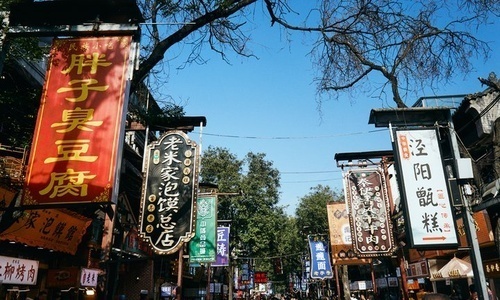 Xi'an Muslim Quarter Travel Guide: Street Food, Culture & Nightlife
Xi'an Muslim Quarter Travel Guide: Street Food, Culture & Nightlife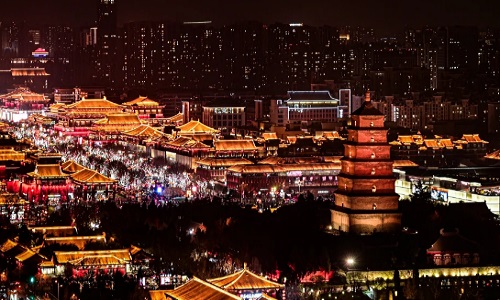 Exploring Grand Tang Mall Xi'an: Shopping, Dining, and Entertainment in the Heart of the Ancient City
Exploring Grand Tang Mall Xi'an: Shopping, Dining, and Entertainment in the Heart of the Ancient City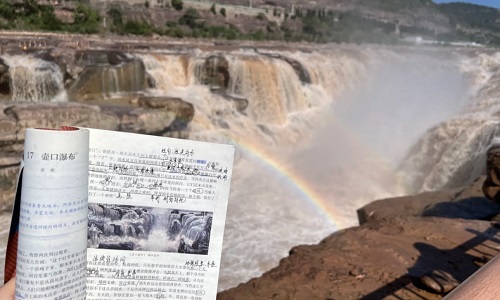 Hukou Waterfall Travel Guide: Visiting the Yellow River’s Most Spectacular Hukou Waterfall from Xi'an
Hukou Waterfall Travel Guide: Visiting the Yellow River’s Most Spectacular Hukou Waterfall from Xi'an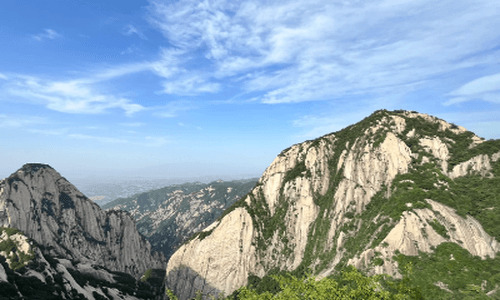 Huashan Mountain Travel Guide: Hiking the Most Dangerous and Beautiful Peak in China
Huashan Mountain Travel Guide: Hiking the Most Dangerous and Beautiful Peak in China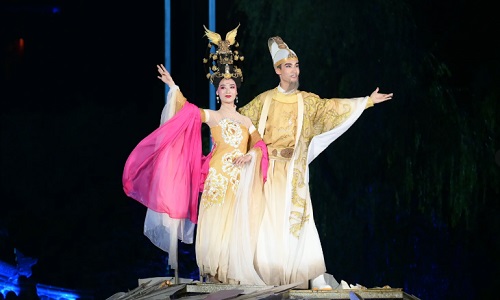 The Song of Everlasting Sorrow: A Timeless Tale of Love and Tragedy in Xi'an
The Song of Everlasting Sorrow: A Timeless Tale of Love and Tragedy in Xi'an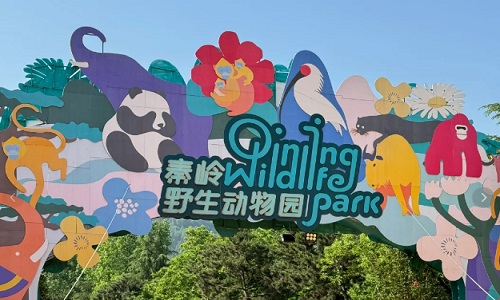 Xi’an Qinling Wildlife Park Travel Guide: Explore the Best Zoo Experience in Xi’an
Xi’an Qinling Wildlife Park Travel Guide: Explore the Best Zoo Experience in Xi’an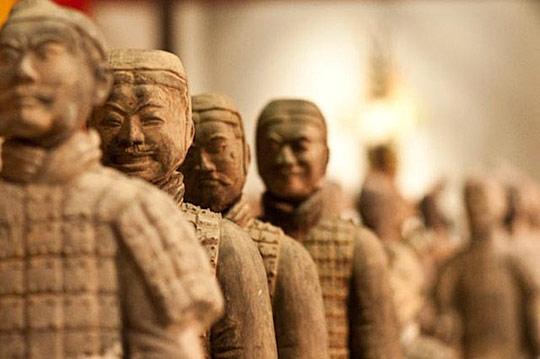 Terracotta Army
Terracotta Army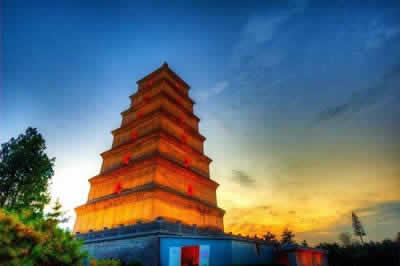 Big Wild Goose Pagoda
Big Wild Goose Pagoda1 to 1 tailor-made service from our professional travel advisors for the most sophisticated
Constantly excellent reviews for attraction, hotel and service Competitive price
Local experts provide quality tours Best selected knowledgeable local guides Authentic local restaurants
7*24 hours available to create you a worry-free tour. No Hidden Fees and absolutely no pressure to buy. Secured









Copyright © 2017 www.xianprivatetour.com All rights reserved. 浙ICP备18056007号-6